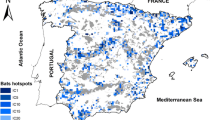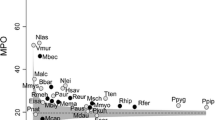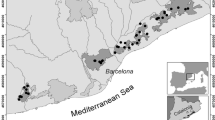Abstract
The conversion of natural areas for the advancement of economic activities such as agriculture, mining, livestock, and energy production are the main challenges for biodiversity conservation in Brazil. The establishment and expansion of protected areas (PA) are the cheapest way to ensure biodiversity protection and the maintenance of ecosystem services provided by it. Chiroptera is one of the most diverse group of mammals, responsible for several ecological functions such as seed dispersal, insect population control and pollination. The aim of our study was to estimate the degree of protection that PAs in Brazil guarantee for bats. Species distribution models were built to estimate the distribution of 173 bat species in the Brazilian territory. Then, we performed a gap analysis to assess the effectiveness of PAs in ensure protection for bats, regarding the administrative level and the type of PA. In general, federal PAs were more efficient in ensuring bat protection than state PAs. Strictly PAs alone are insufficient to protect 67.6% bats, including all endangered bats at national level. Sustainable use areas have a complementary role to achieve the established conservation goals, besides this is not its main purpose. However, more efforts are needed to ensure an effective representation of bat diversity in PAs. Our study shows the need for a more integrated systematic conservation planning that incorporates the federal and local levels. In addition, the inclusion of other types of areas such as indigenous lands and private areas could be effective strategies to ensure that protection goals are met.





Similar content being viewed by others
Data availability
The datasets analyzed during the current study are available in the Supplementary material.
References
de Andrade AFA, Velazco SJE, De Marco Júnior P (2020) ENMTML: an R package for a straightforward construction of complex ecological niche models. Environ Model Softw 125:104615. https://doi.org/10.1016/j.envsoft.2019.104615
Araújo MB, New M (2007) Ensemble forecasting of species distributions. Trends Ecol Evol 22:42–47. https://doi.org/10.1016/j.tree.2006.09.010
Barbet-Massin M, Jiguet F, Albert CH, Thuiller W (2012) Selecting pseudo-absences for species distribution models: how, where and how many? Methods Ecol Evol 3:327–338. https://doi.org/10.1111/j.2041-210X.2011.00172.x
Bernard E, Penna LAOO, Araújo E (2014) Downgrading, Downsizing, Degazettement, and reclassification of protected Areas in Brazil. Conserv Biol 28:939–950. https://doi.org/10.1111/cobi.12298
Bobrowiec PED, Nobre CC, Tavares VC (2021) Immediate effects of an amazonian mega hydroelectric dam on phyllostomid fruit bats. Ecol Indic 132:108322. https://doi.org/10.1016/j.ecolind.2021.108322
Boyer I, Cayuela H, Bertrand R, Isselin-Nondedeu F (2020) Improving biological relevance of model projections in response to climate change by considering dispersal amongst lineages in an amphibian. J Biogeogr 48:561–576. https://doi.org/10.1111/jbi.14019
Brasil (2000) Lei 9.985 de 18 de Julho de 2000. http://www.planalto.gov.br/ccivil_03/leis/l9985.htm/ Accessed on 12 january 2022
Brasil LS, Andrade AFA, Ribeiro BR et al (2021) A niche-based gap analysis for the conservation of odonate species in the brazilian Amazon. Aquat Conserv Mar Freshw Ecosyst 31:1150–1157. https://doi.org/10.1002/aqc.3599
Brondizio ES, Settele J, Díaz S, Ngo HT, IPBES (2019) (2019): Global assessment report on biodiversity and ecosystem services of the Intergovernmental Science-Policy Platform on Biodiversity and Ecosystem Services. Bonn, Germany: IPBES Secretariat
Brooks TM, Pimm SL, Akçakaya HR et al (2019) Measuring terrestrial area of Habitat (AOH) and its utility for the IUCN Red List. Trends Ecol Evol 34:977–986. https://doi.org/10.1016/j.tree.2019.06.009
CNUC (2022) Cadastro Nacional de Unidades de Conservação. In: Painel das Unidades Conserv. Bras. https://www.mma.gov.br/areas-protegidas/cadastro-nacional-de-ucs. Accessed on 23 September 2022
De Marco P, Nóbrega CC (2018) Evaluating collinearity effects on species distribution models: an approach based on virtual species simulation. PLoS ONE 13. https://doi.org/10.1371/journal.pone.0202403
Delgado-Jaramillo M, Barbier E, Bernard E (2017) New records, potential distribution, and conservation of the Near Threatened cave bat Natalus macrourus in Brazil. Oryx 1–8. https://doi.org/10.1017/S0030605316001186
Delgado-Jaramillo M, Aguiar LMS, Machado RB, Bernard E (2020) Assessing the distribution of a species‐rich group in a continental‐sized megadiverse country: bats in Brazil. Divers Distrib 26:632–643. https://doi.org/10.1111/ddi.13043
Dirzo R, Young HS, Galetti M et al (2014) Defaunation in the Anthropocene. Science 345:401–406. https://doi.org/10.1126/science.1251817
dos Reis NR, Peracchi AL, Batista CB et al (2017) História Natural dos Morcegos Brasileiros: Chave de Identificação de Espécies, 1st edn. Technical Books, Rio de Janeiro
Engler R, Guisan A, Rechsteiner L (2004) An improved approach for predicting the distribution of rare and endangered species from occurrence and pseudo-absence data. J Appl Ecol 41:263–274. https://doi.org/10.1111/j.0021-8901.2004.00881.x
Fagundes CK, Vogt RC, de Souza RA, De Marco P Jr (2018) Vulnerability of turtles to deforestation in the brazilian Amazon: indicating priority areas for conservation. Biol Conserv 226:300–310. https://doi.org/10.1016/j.biocon.2018.08.009
Fernández-Llamazares Á, López-Baucells A, Velazco PM et al (2021) The importance of Indigenous Territories for conserving bat diversity across the Amazon biome. https://doi.org/10.1016/j.pecon.2020.11.001. Perspect Ecol Conserv
Fick SE, Hijmans RJ (2017) WorldClim 2: new 1-km spatial resolution climate surfaces for global land areas. Int J Climatol 37:4302–4315. https://doi.org/10.1002/joc.5086
Fonseca CR, Venticinque EM (2018) Biodiversity conservation gaps in Brazil: a role for systematic conservation planning. Perspect Ecol Conserv 16:61–67. https://doi.org/10.1016/j.pecon.2018.03.001
Françoso RD, Brandão R, Nogueira CC et al (2015) Habitat loss and the effectiveness of protected areas in the Cerrado Biodiversity Hotspot. Nat e Conserv 13:35–40. https://doi.org/10.1016/j.ncon.2015.04.001
Frederico RG, Zuanon J, De Marco P (2018) Amazon protected areas and its ability to protect stream-dwelling fish fauna. Biol Conserv 219:12–19. https://doi.org/10.1016/j.biocon.2017.12.032
Frick WF, Kingston T, Flanders J (2020) A review of the major threats and challenges to global bat conservation. Ann N Y Acad Sci 1469:5–25. https://doi.org/10.1111/nyas.14045
Garbino GST, Gregorin R, Lima IP et al (2021) Updated checklist of Brazilian bats: versão 2021. In: Com. da List. Morcegos do Bras. Soc. Bras. para o Estud. Quirópteros (Sbeq). https://www.sbeq.net/lista-de-especies. Accessed on 14 February 2021
Gaston KJ, Charman K, Jackson SF et al (2006) The ecological effectiveness of protected areas: the United Kingdom. Biol Conserv 132:76–87. https://doi.org/10.1016/J.BIOCON.2006.03.013
GBIF.org (2020) GBIF Occurrence Download (Chiroptera). https://doi.org/10.15468/dl.ry9t5m. Accessed on 1 July 2020
Golding N (2014) GRaF: Species Distribution Modelling Using Latent Gaussian Random Fields
Gonçalves F, Sales LP, Galetti M, Pires MM (2021) Combined impacts of climate and land use change and the future restructuring of neotropical bat biodiversity. Perspect Ecol Conserv 19:454–463. https://doi.org/10.1016/j.pecon.2021.07.005
Hansson L-A, Åkesson S (eds) (2014) Animal Movement Across Scales. Oxford University Press, UK
Herrera D, Pfaff A, Robalino J (2019) Impacts of protected areas vary with the level of government: comparing avoided deforestation across agencies in the brazilian Amazon. Proc Natl Acad Sci U S A 116:14916–14925. https://doi.org/10.1073/pnas.1802877116
Hijmans RJ (2021) raster: Geographic Data Analysis and Modeling
IBGE (2021) IBGE – Instituto Brasileiro de Geografia e Estatística. Áreas Territoriais. https://www.ibge.gov.br/geociencias/organizacao-do-territorio/estrutura-territorial/15761-areas-dos-municipios.html?=&t=o-que-e. Accessed on 5 April 2021
IUCN Standards and Petitions Committee (2019) Guidelines for using the IUCN Red List categories and Criteria prepared by the Standards and Petitions Committee of the IUCN Species Survival Commission. THE IUCN RED LIST OF THREATENED SPECIES™
Jennings MD (2000) Gap analysis: concepts, methods, and recent results. Landsc Ecol 15:5–20. https://doi.org/10.1023/A:1008184408300
Jones G, Jacobs DS, Kunz TH et al (2009) Carpe noctem: the importance of bats as bioindicators. Endanger Species Res 8:93–115. https://doi.org/10.3354/esr00182
Karatzoglou A, Smola A, Hornik K, Zeileis A (2004) kernlab-An S4 Package for Kernel Methods in R
Kunz TH, de Torrez EB, Bauer D et al (2011) Ecosystem services provided by bats. Ann N Y Acad Sci 1223:1–38. https://doi.org/10.1111/j.1749-6632.2011.06004.x
Leal ESB, Gomes-Silva FF, de Lira T C, et al (2014) Occurrence of Furipterus horrens (F. Cuvier, 1828) (Chiroptera: Furipteridae) in the state of Paraíba and an update of the distribution of the species in Brazil. Chiropt Neotrop 20:1280–1287
Leroy B, Delsol R, Hugueny B et al (2018) Without quality presence–absence data, discrimination metrics such as TSS can be misleading measures of model performance. J Biogeogr 45:1994–2002. https://doi.org/10.1111/jbi.13402
Li W, Guo Q (2013) How to assess the prediction accuracy of species presence-absence models without absence data? Ecography (Cop) 36:788–799. https://doi.org/10.1111/j.1600-0587.2013.07585.x
Liaw A, Wiener M (2001) Classification and Regression by RandomForest
Maine JJ, Boyles JG (2015) Bats initiate vital agroecological interactions in corn. Proc Natl Acad Sci 112:12438–12443. https://doi.org/10.1073/pnas.1505413112
Margules CR, Pressey RL (2000) Systematic conservation planning. Nat 2000 4056783 405:243–253. https://doi.org/10.1038/35012251
Mascia MB, Pailler S (2010) Protected area downgrading, downsizing, and degazettement (PADDD) and its conservation implications. Conserv Lett 4:9–20. https://doi.org/10.1111/j.1755-263X.2010.00147.x
Mendes P, Velazco SJE, de Andrade AFA, De Marco P (2020) Dealing with overprediction in species distribution models: how adding distance constraints can improve model accuracy. Ecol Modell 431:109180. https://doi.org/10.1016/j.ecolmodel.2020.109180
Moraes B, Razgour O, Souza-Alvez JP, Boubli JP, Bezerra B (2020) Habitat suitability for primate conservation in north-east Brazil. Oryx 54:808–813. https://doi.org/10.1017/S0030605319001388
Muscarella R, Fleming TH (2007) The role of frugivorous bats in tropical forest succession. Biol Rev 82:573–590. https://doi.org/10.1111/j.1469-185X.2007.00026.x
Nóbrega CC, De Marco P (2011) Unprotecting the rare species: a niche-based gap analysis for odonates in a core Cerrado area. Divers Distrib 17:491–505. https://doi.org/10.1111/j.1472-4642.2011.00749.x
Nogueira MR, de Lima IP, Moratelli R et al (2014) Checklist of brazilian bats, with comments on original records. Check List 10:808–821. https://doi.org/10.15560/10.4.808
Novaes RLM, Souza R, de Felix F S et al (2012) New record of Furipterus horrens (Cuvier, 1828)(Mammalia, Chiroptera) from the Cerrado of Tocantins state with a compilation of the known distribution within Brazil. Check List 8:1359–1361. https://doi.org/10.15560/8.6.1359
Oliveira U, Soares-Filho BS, Paglia AP et al (2017) Biodiversity conservation gaps in the brazilian protected areas. Sci Rep 7:9141. https://doi.org/10.1038/s41598-017-08707-2
Pavan AC, Bobrowiec PED, Percequillo AR (2018) Geographic variation in a south american clade of mormoopid bats, Pteronotus (Phyllodia), with description of a new species. J Mammal 99:624–645. https://doi.org/10.1093/jmammal/gyy048
Peres CA (2005) Why we need megareserves in Amazonia. Conserv Biol 19:728–733. https://doi.org/10.1111/j.1523-1739.2005.00691.x
Phillips SJ, Anderson RP, Dudík M et al (2017) Opening the black box: an open-source release of Maxent. Ecography (Cop) 40:887–893. https://doi.org/10.1111/ecog.03049
R Core Team (2021) R: A language and environment for statistical computing. R Foundation for Statistical Computing https://www.R-project.org/
Roberts DR, Bahn V, Ciuti S et al (2017) Cross-validation strategies for data with temporal, spatial, hierarchical, or phylogenetic structure. Ecography (Cop) 40:913–929. https://doi.org/10.1111/ecog.02881
Rodrigues ASL, Andelman SJ, Bakarr MI et al (2003) Global gap analysis: towards a representative network of protected areas. Conservation International, Washington DC
Rodrigues ASL, Akçakaya HR, Andelman SJ et al (2004) Global gap analysis: Priority regions for expanding the global protected-area network. Bioscience 54:1092–1100. https://doi.org/10.1641/0006-3568(2004)054[1092:GGAPRF]2.0.CO;2
Russo D, Salinas-Ramos VB, Cistrone L et al (2021) Do we need to Use Bats as Bioindicators? Biology (Basel) 10:693. https://doi.org/10.3390/biology10080693
Rylands AB, Brandon K (2005) Brazilian protected areas. Conserv Biol 19:612–618. https://doi.org/10.1111/j.1523-1739.2005.00711.x
Silva M (2005) The brazilian protected Areas Program*. Conserv Biol 19:608–611. https://doi.org/10.1111/j.1523-1739.2005.00707.x
Silva JMCda, de Castro Dias TCA, da Cunha AC, Cunha HFA (2019) Public spending in federal protected areas in Brazil. Land use policy 86:158–164. https://doi.org/10.1016/j.landusepol.2019.04.035
Silva JMC, Dias TCA, de Cunha C, da Cunha AC HFA (2021a) Funding deficits of protected areas in Brazil. Land use policy 100:104926. https://doi.org/10.1016/j.landusepol.2020.104926
Silva JMC, Pinto LP, Scarano FR (2021b) Toward integrating private conservation lands into national protected area systems: Lessons from a megadiversity country. Conserv Sci Pract 3:1–8. https://doi.org/10.1111/csp2.433
Sørensen T (1948) A method of establishing groups of equal amplitude in plant sociology based on similarity of species content and its application to analyses of the vegetation on danish commons. Biol Skr 5:1–34
Symes WS, Rao M, Mascia MB, Carrasco LR (2015) Why do we lose protected areas? Factors influencing protected area downgrading, downsizing and degazettement in the tropics and subtropics. Glob Chang Biol 22:656–665. https://doi.org/10.1111/GCB.13089
Vale MM, Berenguer E, Argollo de Menezes M et al (2021) The COVID-19 pandemic as an opportunity to weaken environmental protection in Brazil. Biol Conserv 255. https://doi.org/10.1016/j.biocon.2021.108994
Velazco SJE, Villalobos F, Galvão F, De Marco Júnior P (2019) A dark scenario for Cerrado plant species: Effects of future climate, land use and protected areas ineffectiveness. Divers Distrib 25:660–673. https://doi.org/10.1111/ddi.12886
Vieira RRS, Pressey RL, Loyola R (2019) The residual nature of protected areas in Brazil. Biol Conserv 233:152–161. https://doi.org/10.1016/j.biocon.2019.02.010
Watson JEM, Dudley N, Segan DB, Hockings M (2014) The performance and potential of protected areas. Nat 2014 5157525 515:67–73. https://doi.org/10.1038/nature13947
World Economic Forum (2021) The Global Risks Report 2021 16th Edition
Zanin M, Palomares F, Luísa A, Albernaz M (2021) Effects of climate change on the distribution of felids: mapping biogeographic patterns and establishing conservation priorities. Biodivers Conserv. https://doi.org/10.1007/s10531-021-02147-1
Acknowledgements
This study was financed in part by the Coordenação de Aperfeiçoamento de Pessoal de Nível Superior - Brasil (CAPES) - Finance Code 001 through a scholarship to FPS. PDM received continuous productivity grants from Conselho Nacional de Desenvolvimento Científico e Tecnológico (CNPq) (310547/2020-2). We thank Fabricio Villalobos and Lucas Gonçalves da Silva for comments and suggestions on an earlier draft of this manuscript.
Funding
This study was financed in part by the Coordenação de Aperfeiçoamento de Pessoal de Nível Superior - Brasil (CAPES) - Finance Code 001 through a scholarship to FPS. PDM received continuous productivity grants from Conselho Nacional de Desenvolvimento Científico e Tecnológico (CNPq) (310547/2020-2).
Author information
Authors and Affiliations
Contributions
Felipe Pessoa da Silva: Conceptualization, Resources, Data curation, Formal analysis, Methodology, Writing – original draft. Paulo De Marco Júnior: Conceptualization, Supervision, Resources, Formal analysis, Methodology, Writing – review & editing. All authors read and approved the final manuscript.
Corresponding author
Ethics declarations
Ethical approval
Not applicable.
Competing interests
The authors have no relevant financial or non-financial interests to disclose.
Additional information
Communicated by David Hawksworth.
Publisher’s Note
Springer Nature remains neutral with regard to jurisdictional claims in published maps and institutional affiliations.
Electronic supplementary material
Supplementary data to this article can be found online. Below is the link to the electronic supplementary material.
Rights and permissions
Springer Nature or its licensor (e.g. a society or other partner) holds exclusive rights to this article under a publishing agreement with the author(s) or other rightsholder(s); author self-archiving of the accepted manuscript version of this article is solely governed by the terms of such publishing agreement and applicable law.
About this article
Cite this article
Pessoa da Silva, F., De Marco Júnior, P. The role of protected areas in safeguarding bat diversity in Brazil. Biodivers Conserv 32, 2909–2924 (2023). https://doi.org/10.1007/s10531-023-02635-6
Received:
Revised:
Accepted:
Published:
Issue Date:
DOI: https://doi.org/10.1007/s10531-023-02635-6




